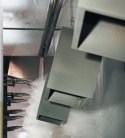Pretreatment System Helps Meet New Standards
Transformer maker tightens corrosion resistance standards and reduces operating costs...
The electrical distribution industry recently tightened its voluntary corrosion resistance standards for outdoor products. As a result, Ermco, a leading manufacturer of pole- and pad-mounted transformers for the utility industry, studied its production procedures seeking improvements that would enable it to meet the new standards.
After a full year of research, the Dyersburg, TN, firm implemented a new pretreatment system that allowed it to meet and exceed the new ANSI (American National Standards Institute) salt spray test requirement and SCAB (Simulated Corrosive Atmospheric Breakdown) standards with every sample. The current ANSI standard requires 1,500 hr salt spray over the entire transformer, and 15 cycles of SCAB. Ermco has achieved 2,000 hours of salt spray, while meeting SCAB requirements virtually 100% of the time.
Pretreatment process critical
"The pretreatment process is critical," commented Ermco's vice president of engineering, Alan L. Wilks. "What I've learned in this business is that you can take average paint and put it over a good pretreatment and you have a good system. However, you can put excellent paint over poor pretreatment and you'll have an inferior system. In our case, through working with Ferro and Henkel Surface Technologies as a team, our total system—paint and pretreatment—has now proven to be excellent.
"We were unable to meet the tighter ANSI standards with the chemical and paint we had been using," Mr. Wilks said. "We conducted tests on a variety of pretreatment processes for approximately one year when we tested new Parcolene® 7100 non-chrome dry-in-place post treatment process. Upon conclusion of the trial, it was the first time I had something pass 100% of the time. Until then, the parts passed intermittently, but there was nothing I could hang my hat on with confidence."
Ermco produces single-phase pole- and pad-mounted transformers for the entire utility industry that consists of investor-owned, municipals and rural electric cooperatives. The units range from 5 to 250 KvA with primary voltages ranging from 2,400 to 19,920.
The company produces the entire units from metal bending for tanks to painting, assembly and testing. The transformers are AutoCad designed and tanks are cut via a computer-controlled Amada turret punch. All transformers are 100% electrically tested while paint millage and impact testing are conducted randomly on hundreds of units daily.
Six-stage pretreatment process
"Our base material is carbon steel, mild steel or stainless. However, the stainless steel is used only on units earmarked for highly corrosive areas like coastal regions," Mr. Wilks pointed out. "After fabrication, we paint the units. Since the life span on these units is approximately 30 years, it requires a very good coating system in which the chemical pretreatment system is critical."
The pretreatment system consists of a five-stage process. The parts are first put through a Parco® alkaline cleaning stage that is followed by a two-stage water rinse that includes a recirculating water rinse and then a fresh water rinse. This is followed by a Bonderite® 1045 iron phosphate bath. The parts are then put through another double water rinse before the final stage where they pass through the Parcolene® 7100 non-chrome dry-in-place post treatment. The parts are then passed through a dry-off oven at 200F before proceeding to the powder coating line.
Passing the test every time
"We experimented with the post treatment process and finally settled on the optimum solution," Mr. Wilks remarked. "We tested more than 100 panels without a failure. With the SCAB or salt spray, you scratch the paint down to bare metal to conduct the test. You measure how much paint actually lifts off the steel. We're expected to have a rating of six or better on a scale of one to 10. This translates to less than a three-millimeter lift from the scribe. Our ratings have consistently ranged between six and eight and an occasional nine. Those ratings are obtained from both SCAB and salt spray testing," Mr. Wilks emphasized.
According to Mr. Wilks, the SCAB test simulates more of a real life situation. It has heating, cooling, humidity and salt, and it does it on a cycling basis. On lids, Ermco applies two or three coats of paint to achieve extra millage for improved insulating properties. Three mils of paint is normal on tanks. What the company has learned is that on SCAB tests, millage is not as critical as it is for salt spray tests. "With heavy paint millage, we can pass a salt spray test, but we are unable to pass the SCAB test without a good pretreatment process," Mr. Wilks noted.
"At present, we're very pleased," Mr. Wilks stressed. "We've had great technical assistance from Henkel in setting up our new system. They have also provided helpful training for our people on how to control the baths. Credit should also be given to Ferro for providing a very efficient powder coating. It's been a great team effort, enabling us to easily meet and exceed all of the required standards. All in all, we couldn't be happier," Mr. Wilks concluded.
To learn more visitHenkel Corporation.
Read Next
A ‘Clean’ Agenda Offers Unique Presentations in Chicago
The 2024 Parts Cleaning Conference, co-located with the International Manufacturing Technology Show, includes presentations by several speakers who are new to the conference and topics that have not been covered in past editions of this event.
Read MoreEpisode 45: An Interview with Chandler Mancuso, MacDermid Envio Solutions
Chandler Mancuso, technical director with MacDermid Envio discusses updating your wastewater treatment system and implementing materials recycling solutions to increase efficiencies, control costs and reduce environmental impact.
Read MoreEducation Bringing Cleaning to Machining
Debuting new speakers and cleaning technology content during this half-day workshop co-located with IMTS 2024.
Read More











.jpg;maxWidth=300;quality=90)










